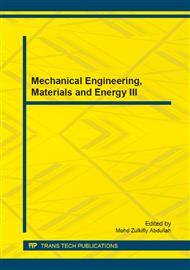[1]
Bureau of Energy, MOE Taiwan, Framework of Taiwan's sustainable energy policy, available: http: /www. moeaboe. gov. tw/, June, (2008).
Google Scholar
[2]
W.T. Tsai, Current status and development policies on renewable energy technology research in Taiwan, Renewable & Sustainable Energy Reviews, 9 (2005), 237-253.
DOI: 10.1016/j.rser.2004.03.003
Google Scholar
[3]
K.T. Chou and H.M. Liou, Analysis on energy intensive industries under Taiwan's climate change policy, Renewable & Sustainable Energy Reviews, 16 (2012), 2631-2642.
DOI: 10.1016/j.rser.2012.01.057
Google Scholar
[4]
J.N. Sheen, Fuzzy financial profitability analyses of demand side management alternatives from participant perspective, Information Sciences, 169 (2005), 329-364.
DOI: 10.1016/j.ins.2004.05.007
Google Scholar
[5]
J.N. Sheen, Fuzzy financial decision-making: load management programs case study, IEEE Transactions on Power Systems, 20 (2005), 1808-1817.
DOI: 10.1109/tpwrs.2005.856994
Google Scholar
[6]
A. Kaufmann and M.M. Gupta, Fuzzy Mathematical Models in Engineering and Management Science, Elsevier Science Publishers B.V. (1988).
Google Scholar
[7]
C.Y. Chiu and C.S. Park, Fuzzy Cash Flow Analysis using Present Worth Criterion, The Engineering Economist, 39 (1994), 113-137.
DOI: 10.1080/00137919408903117
Google Scholar
[8]
C. Kahraman, D. Ruan and E. Tolga, Capital budgeting techniques using discounted fuzzy versus probabilistic cash flows, Information Sciences, 142 (2002), 57-76.
DOI: 10.1016/s0020-0255(02)00157-3
Google Scholar
[9]
W.C. Giffin, Transform Techniques for Probability Modeling, Academic Press, New York, (1975).
Google Scholar
[10]
Mathew S. Wind Energy, Springer-Verlag Berlin Heidelberg, (2006).
Google Scholar
[11]
Cheng TP. Wind energy assessment incorporating particle swarm optimization method. Energy Conversion & management, 52 (2011), 1630-1637.
DOI: 10.1016/j.enconman.2010.10.024
Google Scholar
[12]
Steffen Jenner, Felix Groba, and Joe Indvik, Assessing the strength and effectiveness of renewable electricity feed-in tariffs in European Union countries, Energy Policy, 52(2013), 385-401.
DOI: 10.1016/j.enpol.2012.09.046
Google Scholar


